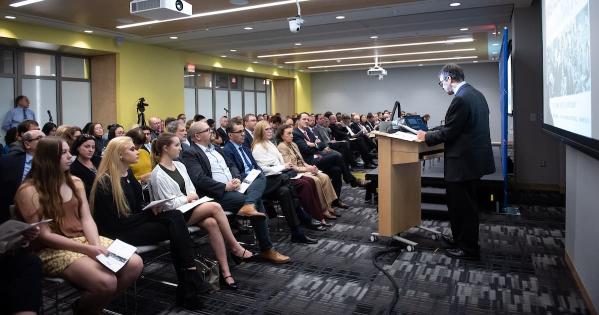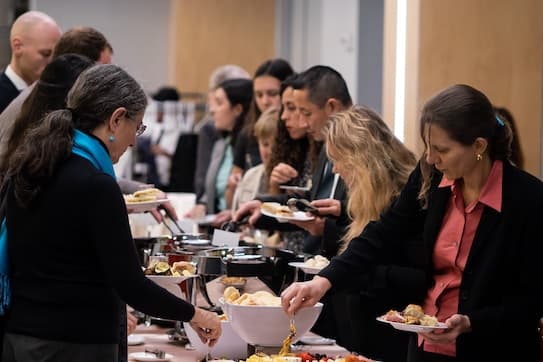Armistice and Revolution Symposium

The Carmel Institute’s seventh symposium began with our Director emphasizing the Institute’s mission to promote Russian-American dialogue and better knowledge of Russian culture and history. The symposium focused on the First World War’s impact on the world and how it is remembered today. The Susan Carmel Chair for Russian History at American University Professor Eric Lohr highlighted the importance of World War One in the Russian Revolution’s beginnings and the devastating Civil War Russia experienced into the 1920s—an event that is hardly memorialized in Russia today. Dr. Lohr argued that the situation at the front precluded any military help for Kerensky when unrest broke out with the Bolshevik coup d’etat and subsequent bitter war between the Reds and the Whites. He concluded that “in Russia, World War One did not really end, and Russia did not have its own armistice.”
Independent scholar and AU alum Dr. Borislav Chernev next spoke about how the Brest-Litovsk Treaty came about. His 2017 book Twilight of Empire: The Brest-Litovsk Conference and the Remaking of East-Central Europe, 1918-1918, is one of the best explorations of this important diplomatic settlement. Dr. Chernev argued that for the Bolsheviks the treaty negotiations were not about actually ending the fighting on the Eastern Front, but about sending the message across Europe for socialists to rise up against the imperialists and join Russia’s revolution. In the meantime, the British blockade was raising fears, especially in the Austro-Hungarian Empire, that starvation would cause exactly the kind of socialist uprisings Trotsky and his proxy Joffe hoped to promote. But the failure of several attempted uprisings within Germany and Austro-Hungary and further military advances from the Central Powers into Russian territory forced the Bolsheviks to sign the treaty giving up a third of Russia’s territory. However, Dr. Chernev emphasized that the dream of a world socialist revolution continued under the Communist International (COMINTERN), which was established in 1919. Ultimately, according to Dr. Chernev, this dream was the key to understanding what the Bolsheviks hoped World War One would accomplish, and that idea of world revolution “never really died until the very last days of the Soviet Union’s existence.”
Professor Elizabeth Wood of the Massachusetts Institute of Technology brought out the crucial role of Russian women over the course of World War One, both revolutions in 1917, and civil war. Dr Wood asserted it is Russian women who sparked the February Revolution and made Russia one of the first countries on Earth where women could vote in March 1917. Moreover, she argued that the Bolsheviks specifically sought out women’s support from 1913 and into the 1920s when family law codes took effect that gave women more rights than most women enjoyed in Western societies at the time (and that we take for granted today). Ironically, politically repressive Bolshevik Russia emerged as an important leader in the area of women’s rights. There were very practical reasons for this because the Bolsheviks pursued specific policy goals, including to undermine the Russian Orthodox Church. Dr. Wood concluded that women’s rights in Russia was a central goal for the Bolsheviks’ program to build a new Russia.
Professor David Engerman of Yale University then connected the earlier presentations with the Bolsheviks’ international goals and how they intersected with the need to convert a largely uneducated agrarian society into the proletariat class that Marxism demanded and ultimately to overthrow the capitalist world system. He highlighted how Lenin reached out to the Muslim regions in the southern parts of the Russian Empire and the colonized peoples in India, Ireland, and Egypt to rise up against the British and join Russia in a global socialist revolution. However, Dr. Engerman argued that the early COMINTERN focused firmly on Europe with the assumption that world revolution must start there and reached out to the colonies only as hopes for European revolutions faded. Dr. Engerman traced how the Bolshevik dream of global revolution shifted in the face of real-world events from their original assumption of a European-led transformation into a pluralized dream, where revolutionaries around the world would create the communist world system together.
The last presenter, Professor Alexei Miller of the European University at St. Petersburg, Russia, spoke to how the First World War is remembered in Russia. He argued that the conflict stood deep in the shadow of the October Bolshevik Revolution and the Great Patriotic War (World War Two) throughout the Soviet era. Then after the fall of the Soviet Union, the October Revolution also faded from the public eye with the end of the commemorative parades in Red Square and renaming October Revolution Day into the Day of Accord and Reconciliation. And as interest in Revolution Day faded, Dr. Miller asserted, the First World War recovered from its near erasure in terms of “at least three important narratives.” First, the Russian Orthodox Church condemned both revolutions (while generally ignoring the role that Orthodox clergy played in the February revolution). Second, today’s Communist Party has claimed that the October Revolution was the starting point for Russia’s true power and influence as a great power. And third, there is the liberal argument that the February Revolution was “stolen by the Bolsheviks” and prevented Russia from having a much more prominent role in World War One and its conclusion. Of these three narratives, Dr. Miller argued that the organizational erosion of local governments in 1917 came only after the October Revolution triggered a “civilizational collapse” that led to mass starvation and rationing. In other words, it was not the First World War or the October Revolution, but the Russian Civil War that was the turning point for Russia and the world.
Carmel Institute Director and AU Professor Anton Fedyashin then added that the February Revolution was the most significant from the American perspective, as it enabled President Woodrow Wilson to frame the U.S. entry in the war as “making the world safe for democracy,” which the Russian Empire became after the fall of the Romanovs. But this also set President Wilson’s vision of a new world order on a collision course with Lenin’s equally universalist and messianic quest to remake geopolitics. Dr. Fedyashin then moderated a question-and-answer session with all 5 panelists.
To understand each speaker’s full argument, we urge you to watch the full video of the symposium. To find the beginning of each panel presentation,
- Dr. Lohr’s remarks begin the panel discussion at 14:15,
- Dr. Chernev steps forward at 26:46,
- Dr. Wood takes the podium at 43:13,
- Dr. Engerman’s presentation begins at 54:44, and
- Dr. Miller provides a Russian perspective from 1:07:45.
- Dr. Fedyashin’s comments can be found at the 1:21-minute mark and the Q&A, beginning at 1:24, adds more depth to the presentations and gives the panel a chance to exchange views on issues of particular interest to the audience.
To receive email notification of our future events, please send an email to carmelinstitute@american.edu with a request to join our email list.

